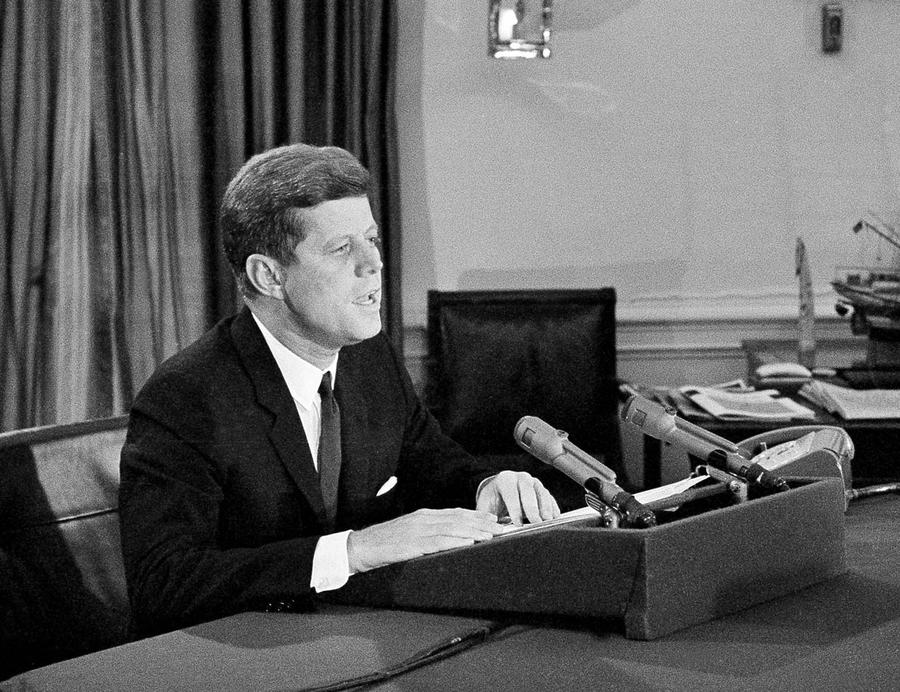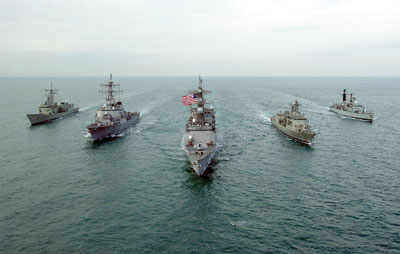
At 8:45 AM on October 16, 1962, the National Security Advisor alerted President Kennedy that a major international crisis was at hand.
Spend 3 minutes to watch his speech.
Two days earlier a United States military surveillance aircraft had taken hundreds of aerial photographs of Cuba. CIA analysts, working around the clock, had deciphered in the pictures conclusive evidence that a Soviet missile base was under construction near San Cristobal, Cuba; just 90 miles from the coast of Florida.

The most dangerous encounter in the Cold War rivalry between the United States and the Soviet Union had begun.
After President Kennedy and national defense officials were briefed on the U-2 spy plane findings, discussions began on how to respond to the challenge. Two principal courses were offered: an air strike and invasion, or a naval quarantine with the threat of further military action.
To avoid arousing public concern, the president maintained his official schedule, meeting periodically with advisors to discuss the status of events in Cuba and possible strategies.

After many long and difficult meetings, Kennedy decided to place a naval blockade, or a ring of ships, around Cuba. The aim of this “quarantine,” as he called it, was to prevent the Soviets from bringing in more military supplies. He demanded the removal
of the missiles already there and the destruction of the sites.
On October 22, President Kennedy spoke to the nation about the crisis in a televised address. No one was sure how Soviet leader Nikita Khrushchev would respond to the naval blockade and U.S. demands. But the leaders of both superpowers recognized the
devastating possibility of a nuclear war and publicly agreed to a deal in which the Soviets would dismantle the weapon sites in exchange for a pledge from the United States not to invade Cuba.
In a separate deal, which remained secret for more than twenty-five years, the United States also agreed to remove its nuclear missiles from Turkey. Although the Soviets removed their missiles from Cuba, they escalated the building of their military arsenal; the missile crisis was over, the arms race was not.
Watch this trailer for a movie called "Thirteen Days" which depicted this historical era.
Watch this 3 minute video about the Cuban Missile Crisis.
If you are interested in "Ten Fascinating Facts about Cuba."
Comment: Research on the Internet and share one interesting thing that you discovered about the Cold War "Arms Race."

These two facts are awesome to me!
ReplyDelete1) The US B-52 bomber could fly 6,000 miles and deliver a nuclear bomb.
2) It is estimated that by 1961 there were enough nuclear bombs built to destroy the world.
A fact that I found interesting was The Manhattan Project was top secret, But Soviet Union leader Joseph Stalin's spies were so good, he knew all about it. No wonder everyone was freaking out about spies.
ReplyDeleteI thought it was interesting that during the Cold War, America used bears to test their ejector seats for supersonic jets.
ReplyDeleteI thought that it was interresting that there are 50 U2 spy planes in use today, also that it was cool to know is that america had more warheads through out the entire cold war.
ReplyDeleteWhat I found interesting is that the emergency broadcast was introduced in 1963 but has not been used as of yet.
ReplyDeleteTwo facts I found interesting were that 1. The U-2 aerial photographs were analyzed inside a secret office above a used car dealership, and 2. To keep news of the crisis from leaking, a concocted cold was blamed for President Kennedy’s cancellation of public events.
ReplyDeleteOne fact I learned is that U.S. Senator Joseph McCarthy begins his communist witch hunt in the United States in 1950.
ReplyDeletethe H-bomb is smaller than the Atom-bomb but 2500 times stronger
ReplyDeleteI learned that some bombers carried AN-22 Gravity Bombs and missiles.
ReplyDeleteI learned that: it is estimated that by 1961 there were enough nuclear bombs built to destroy the world. 0.0
ReplyDeleteI learned that the first arms race included france!!
ReplyDeleteI learned that a major factor of the Cold war was the term "Mutual Assured Destruction" or MAD, which meant that both countries were able to destroy each other in case of an attack, that they were both able to eliminate each other.
ReplyDeleteThe Cold War left us with Nuclear warhead stockpiles.The US has built around 70,000 nuclear warheads since 1945.
ReplyDelete